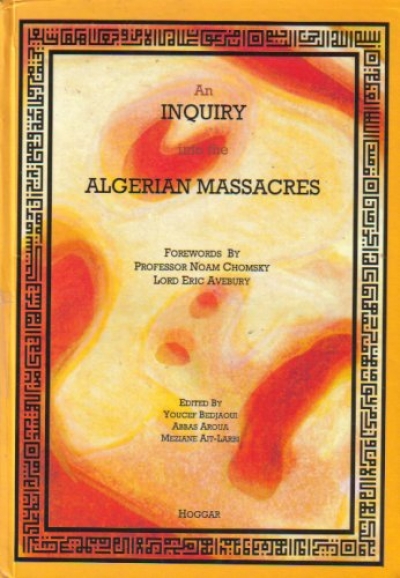



 Iqbal Siddiqui
Iqbal Siddiqui
AN ENQUIRY INTO THE ALGERIAN MASSACRES edited by Youcef Bedjaoui, Abbas Aroua and Meziane Ait-Larbi. Pub: Hoggar Books, Geneva, Switzerland, 1999. Hbk: UK24.00 (UK); pp: 1,473.
The impressive size of this book seems at first sight to reflect the scale of the pain and confusion caused by Algeria's bloody history over the past decade. The regular media reports of massacres and other atrocities again civilians - including women and children - have been greeted with understandable shock and horror across the world. Muslims have instinctively rejected that claim that they are committed by 'mujahideen' supposedly representing the country's Islamic movement - excluded from power by a military coup after winning elections in December 1991 - saying that no Islamic movement could possibly commit such barbaric acts. But supporting evidence for this instinct has often appeared thin, particularly compared to the voluminous propaganda of the secular regime and its western supporters. This volume changes that for good.
However, the size of this massive tome should put no-one off, for it is not a single book but a selection of 30 papers on different aspects of the massacres, each of which stands alone and is a substantial contribution to the subject in its own right. The papers, contributed by Algerian academics, lawyers and human rights activists, are divided thematically into six sections. The first is called 'Massacres and Victims', and includes four papers looking at the direct facts of the massacres. The second, called 'Intents and Perpetrators', looks at the key issues of the object of the massacres and the identity of those responsible. The titles of the third and fourth sections, 'National Responses' and 'International Responses', are self-explanatory. The fifth section places the massacres of the 1990s in historic perspective, while the sixth looks at legal perspectives. The volume concludes with a small collection of photographs from the world press, which graphically illustrates the horrors discussed so coolly in the rest of the book.
The size and depth of the contributions vary, although the quality is (unusually for a compendium of this sort) almost uniformly high. However, the core of the book can be said to be three substantial papers which are almost small books in their own right. These are 'An Anatomy of the Massacres' by Meziane Ait-Larbi and others, in the first section; and the two papers which make up the second section: 'On the Politics of the Massacres' by Youcef Bedjaoui, and 'What is the GIA?' by B. Izel and others. These three papers together address the key questions raised by the massacres, and provide convincing answers, while the rest of the papers can be thought of as excellent supporting and complimentary material.
The Ait-Larbi paper provides a statistical analysis of the location, timing, severity and victims of over 600 massacres, to provide data on the phenomenon as a whole. While most observers are stunned beyond comprehension by the cruelty of individual episodes, this cold-blooded and objective analysis provides data on which definite conclusions can be drawn about the nature of the atrocities. Although the authors concentrate on the data rather than on drawing conclusions from it, the data tells its own story, showing how the timing of the massacres has reflected the political needs of the ruling elite (shortly before elections, for example); that they have taken place predominantly in areas which have been strongholds of the Islamic movement; and the victims have been the most defenceless sections of society. The complex and detailed statistical analyses defy easy summary, but the trends are clear. The paper also provides information on the modus operandi and weapons of the perpetrators of the atrocities.
Youcef Bedjaoui's paper uses the data and patterns revealed by Ait-Larbi et al, and other data, to review the five major explanations most commonly presented for the massacres: that they are punitive mass-murders on the part of the Islamic movement; that they are counter-insurgency operations by the regime; that they are carried out by hardline 'eradicators' in the military to marginalise other factions; that they are depopulation tactics used by land speculators; and that they are the result of social criminality and family or tribal vendettas, commonly referred to as a 'barbarian cycle' in the French press.
In critically analysing each of these hypotheses, Bedjaoui's balance and open-mindedness is admirable, and his conclusions clear in view of the evidence presented. He also highlights the discrepancies between different sources of information on the same incidents, be they the victims, the alleged perpetrators, the Algerian government, NGOs or the media. His own conclusion is that the data tends to suggest that the violence is due to a combination of the counter-insurgency and factional war (within the military) explanations; but, he says, "the analysis is not conclusive". In fact, while his objectivity is admirable, most readers of the closely-argued paper will need little more convincing.
The third key paper, 'What is the GIA?', goes to the very heart of the issue - the identity and objectives of the group generally blamed for most of the worst atrocities. Izel et al argue that the GIA has not been a single and unchanging entity from its emergence during 1992 through to the present, but has changed over time in response to various factors. They show that, although the GIA began in 1992 as part of the Islamic movement, led by well-known Islamic leaders, its character changed as its major leaders and large numbers of its fighters were quickly arrested and killed. The group (or the name) was then taken over by others whose identity has been far more shady, but it has continued to be identified with the Islamic movement by the government and its propagandists.
It was then that the GIA's emphasis changed from fighting the military regime to attacking the Islamic Salvation Front (FIS) and other anti-government groups. This has been portrayed as infighting within the Islamic movement by the Algerian regime and its supporters, but this paper argues that the group's operations and targets can only be explained if they are seen as part of the government's counter-insurgency (COIN) strategy. This is based on a thorough and impressive analysis of COIN theory by western strategists, and COIN operations around the world, including Angola, Nicaragua, Turkey, Spain, Northern Ireland and Algeria itself during French rule and the war of independence.
The case Izel et al make is largely circumstantial, inevitably; but the sheer volume of evidence brought forward, and the fact that they consider other possible explanations with similar fairness before dismissing them, is convincing. Few readers will be able to avoid the conclusion that the GIA is indeed a part of the Algerian regime's counter-insurgency strategy rather than an anti-government movement.
These three papers constitute the core of the book and its argument. But most of the other material is informative and fascinating too, and add considerably to any reader's understanding of the situation. The paper 'Voices of the Voiceless', by M. Farouk and others (including Ait-Larbi) provides a superb and moving counter-balance to the deliberate (and necessary) dispassion of other papers, highlighting the human experiences of victims and survivors of various atrocities. Other papers look at the reactions of various parties, including the Algerian military, other governments (western and Muslim), the UN and other international bodies, and Islamic movements outside Algeria. A section on the 'Historical Perspective' highlights precedents for the massacres during French rule and, interestingly, in October 1988, when the Algerian government cracked down on popular protest; all of these precedents, notably, were clearly the work of Algeria's western and secular rulers, not of popular Islamic movements.
This is an essential and invaluable work for understanding Algeria's recent turmoil, for specialists and general readers alike. The incredible and unimaginable suffering of Algeria's Muslims over the last 10 years demands that other Muslims make the effort of getting past their own inevitable anger and pain in order to try to understand the truth of the tragedy there, which is continuing to this day.
